Hybrid Systems Based on Talc and Chitosan for Controlled Drug Release
Abstract
:1. Introduction
2. Results and Discussion
2.1. Characterizations
2.2. Drug Loading Efficiency and Release Tests
- n = 0.43: Fickian diffusion (Case-I);
- 0.43 < n < 0.85: Non-Fickian transport (anomalous);
- n = 0.85: Case II transport;
- n > 0.85: Super-Case II transport.
3. Materials and Methods
3.1. Materials
3.2. Synthesis of Magnesium Phyllosilicate (Talc)
3.3. Purification of Ch
3.4. Synthesis of Inorganic-Organic Hybrid Talc + Ch
3.5. Characterizations
3.5.1. Fourier Transform Infrared
3.5.2. X-Ray Diffraction
3.5.3. Thermogravimetric Analysis
3.6. Drug Loading Efficiency and Release Tests
3.6.1. Amiloride Loading
3.6.2. In Vitro Drug Release Tests
3.6.3. Statistical Analysis of Data
4. Conclusions
Author Contributions
Funding
Acknowledgments
Conflicts of Interest
References
- Jasrotia, D.; Singh, B.; Kumar, A.; Verma, S.K.; Alvi, P.A.; Kumar, K.; Sridhar, B. [HgCl4]2−[C5H6 N2Cl]2 + inorganic-organic hybrid material with structural and optical properties. Results Phys. 2019, 14, 0–3. [Google Scholar] [CrossRef]
- Jasrotia, D.; Verma, S.K.; Sridhar, B.; Alvi, P.A.; Kumar, A. 3D-2D lattice dimensionality, optical Eg and PL energy variations due to organic variant in two [ZnCl4]2- based hybrid materials. Mater. Chem. Phys. 2018, 207, 98–104. [Google Scholar] [CrossRef]
- Singh, B.; Thakur, A.; Kumar, M.; Verma, S.K.; Jasrotia, D. Structural and optical properties of inorganic–organic hybrid material of acetanilide tetrachloromercurate(II). J. Mater. Sci. Mater. Electron. 2017, 28, 10007–10011. [Google Scholar] [CrossRef]
- Roviello, G.; Menna, C.; Tarallo, O.; Ricciotti, L.; Ferone, C.; Colangelo, F.; Asprone, D.; di Maggio, R.; Cappelletto, E.; Prota, A.; et al. Preparation, structure and properties of hybrid materials based on geopolymers and polysiloxanes. Mater. Des. 2015, 87, 82–94. [Google Scholar] [CrossRef]
- Kim, S.Y.; Choi, Y.S. Preparation of magnesium-based two-dimensional phyllosilicate materials and simultaneous antioxidant drug intercalation. Colloids Surfaces A Physicochem. Eng. Asp. 2019, 569, 164–170. [Google Scholar] [CrossRef]
- Hamilton, A.R.; Roberts, M.; Hutcheon, G.A.; Gaskell, E.E. Formulation and antibacterial properties of clay mineral-tetracycline and -doxycycline composites. Appl. Clay Sci. 2019, 179. [Google Scholar] [CrossRef]
- Akbal, O.; Vural, T.; Malekghasemi, S.; Bozdoğan, B.; Denkbaş, E.B. Saponin loaded montmorillonite-human serum albumin nanocomposites as drug delivery system in colorectal cancer therapy. Appl. Clay Sci. 2018, 166, 214–222. [Google Scholar] [CrossRef]
- Lee, Y.S.; Song, J.G.; Lee, S.H.; Han, H.K. Sustained-release solid dispersion of pelubiprofen using the blended mixture of aminoclay and ph independent polymers: Preparation and in vitro/in vivo characterization. Drug Deliv. 2017, 24, 1731–1739. [Google Scholar] [CrossRef]
- Cernei, E.R.; Maxim, A.; Maxim, D.C.; Mavru, R.B.; Zegan, G. Textural properties of amoxicillin-Anionic clays composites for possible oral diseases uses. Rev. Chim. 2016, 67, 1306–1308. [Google Scholar]
- Silva, F.D.C.; Lima, L.C.B.; Honório, L.M.C.; Trigueiro, P.; Osajima, J.A.; Lobo, A.O.; Filho, E.C.S. Clays as Biomaterials in Controlled Drug Release: A Scientific and Technological Short Review. Biomed. J. Sci. Tech. Res. 2019, 1–6. [Google Scholar] [CrossRef]
- Massaro, M.; Colletti, C.G.; Lazzara, G.; Riela, S. The use of some clay minerals as natural resources for drug carrier applications. J. Funct. Biomater. 2018, 9, 58. [Google Scholar] [CrossRef] [PubMed]
- Cavalcanti, G.R.S.; Fonseca, M.G.; da Silva Filho, E.C.; Jaber, M. Thiabendazole/bentonites hybrids as controlled release systems. Colloids Surf. B 2019, 176, 249–255. [Google Scholar] [CrossRef] [PubMed]
- Bera, H.; Abbasi, Y.F.; Yoke, F.F.; Seng, P.M.; Kakoti, B.B.; Ahmmed, S.K.M.; Bhatnagar, P. Ziprasidone-loaded arabic gum modified montmorillonite-tailor-made pectin based gastroretentive composites. Int. J. Biol. Macromol. 2019, 129, 552–563. [Google Scholar] [CrossRef] [PubMed]
- Akbari Alavijeh, M.; Sarvi, M.N.; Ramazani Afarani, Z. Modified montmorillonite nanolayers for nano-encapsulation of biomolecules. Heliyon 2019, 5, e01379. [Google Scholar] [CrossRef] [PubMed] [Green Version]
- Zheng, L.; Zhou, B.; Qiu, X.; Xu, X.; Li, G.; Lee, W.Y.W.; Jiang, J.; Li, Y. Direct assembly of anticancer drugs to form Laponite-based nanocomplexes for therapeutic co-delivery. Mater. Sci. Eng. C 2019, 99, 1407–1414. [Google Scholar] [CrossRef]
- Cheikh, D.; García-Villén, F.; Majdoub, H.; Zayani, M.B.; Viseras, C. Complex of chitosan pectin and clay as diclofenac carrier. Appl. Clay Sci. 2019, 172, 155–164. [Google Scholar] [CrossRef]
- Luo, C.; Yang, Q.; Lin, X.; Qi, C.; Li, G. Preparation and drug release property of tanshinone IIA loaded chitosan-montmorillonite microspheres. Int. J. Biol. Macromol. 2019, 125, 721–729. [Google Scholar] [CrossRef]
- Liu, K.H.; Liu, T.Y.; Chen, S.Y.; Liu, D.M. Effect of clay content on electrostimulus deformation and volume recovery behavior of a clay-chitosan hybrid composite. Acta Biomater. 2007, 3, 919–926. [Google Scholar] [CrossRef]
- Wang, S.F.; Shen, L.; Tong, Y.J.; Chen, L.; Phang, I.Y.; Lim, P.Q.; Liu, T.X. Biopolymer chitosan/montmorillonite nanocomposites: Preparation and characterization. Polym. Degrad. Stab. 2005, 90, 123–131. [Google Scholar] [CrossRef]
- Chen, L.; Wu, P.; Chen, M.; Lai, X.; Ahmed, Z.; Zhu, N.; Dang, Z.; Bi, Y.; Liu, T. Preparation and characterization of the eco-friendly chitosan/vermiculite biocomposite with excellent removal capacity for cadmium and lead. Appl. Clay Sci. 2018, 159, 74–82. [Google Scholar] [CrossRef]
- Ali, A.; Ahmed, S. A review on chitosan and its nanocomposites in drug delivery. Int. J. Biol. Macromol. 2018, 109, 273–286. [Google Scholar] [CrossRef] [PubMed]
- Santana, A.C.S.G.V.; Sobrinho, J.L.S.; da Silva Filho, E.C.; Nunes, L.C.C. Obtaining the palygorskite:chitosan composite for modified release of 5-aminosalicylic acid. Mater. Sci. Eng. C 2017, 73, 245–251. [Google Scholar] [CrossRef] [PubMed]
- Yahia, Y.; García-Villén, F.; Djelad, A.; Belaroui, L.S.; Sanchez-Espejo, R.; Sassi, M.; López-Galindo, A.; Viseras, C. Crosslinked palygorskite-chitosan beads as diclofenac carriers. Appl. Clay Sci. 2019, 180, 105169. [Google Scholar] [CrossRef]
- Khlibsuwan, R.; Siepmann, F.; Siepmann, J.; Pongjanyakul, T. Chitosan-clay nanocomposite microparticles for controlled drug delivery: Effects of the MAS content and TPP crosslinking. J. Drug Deliv. Sci. Technol. 2017, 40, 1–10. [Google Scholar] [CrossRef]
- Yang, J.H.; Lee, J.H.; Ryu, H.J.; Elzatahry, A.A.; Alothman, Z.A.; Choy, J.H. Drug–clay nanohybrids as sustained delivery systems. Appl. Clay Sci. 2016, 130, 20–32. [Google Scholar] [CrossRef]
- Fetouh, H.A.; Ismail, A.M.; Hamid, H.A.; Bashier, M.O. Synthesis of promising nanocomposites from an antitumer and biologically active heterocyclic compound uploaded by clay and chitosan polymers. Int. J. Biol. Macromol. 2019, 137, 1211–1220. [Google Scholar] [CrossRef]
- Raut, S.Y.; Gahane, A.; Joshi, M.B.; Kalthur, G.; Mutalik, S. Nanocomposite clay-polymer microbeads for oral controlled drug delivery: Development and, in vitro and in vivo evaluations. J. Drug Deliv. Sci. Technol. 2019, 51, 234–243. [Google Scholar] [CrossRef]
- El-Hamshary, H.; El-Newehy, M.H.; Moydeen Abdulhameed, M.; El-Faham, A.; Elsherbiny, A.S. Evaluation of clay-ionene nanocomposite carriers for controlled drug delivery: Synthesis, in vitro drug release, and kinetics. Mater. Chem. Phys. 2019, 225, 122–132. [Google Scholar] [CrossRef]
- Taherzade, S.D.; Soleimannejad, J.; Tarlani, A. Application of metal-organic framework Nano-MIL-100(Fe) for sustainable release of doxycycline and tetracycline. Nanomaterials 2017, 7, 215. [Google Scholar] [CrossRef]
- de Sousa Rodrigues, L.A.; Figueiras, A.; Veiga, F.; de Freitas, R.M.; Nunes, L.C.C.; da Silva Filho, E.C.; da Silva Leite, C.M. The systems containing clays and clay minerals from modified drug release: A review. Colloids Surf. B 2013, 103, 642–651. [Google Scholar] [CrossRef]
- Nastase, S.; Bajenaru, L.; Matei, C.; Mitran, R.A.; Berger, D. Ordered mesoporous silica and aluminosilicate-type matrix for amikacin delivery systems. Microporous Mesoporous Mater. 2013, 182, 32–39. [Google Scholar] [CrossRef]
- Su, Z.F.; Abbasi, F.; Leitch, J.J.; Faragher, R.J.; Schwan, A.L.; Lipkowski, J. Mechanisms of alamethicin ion channel inhibition by amiloride in zwitterionic tethered lipid bilayers. J. Electroanal. Chem. 2019, 848, 113281. [Google Scholar] [CrossRef]
- Shah, J.V.; Shah, P.A.; Sanyal, M.; Shrivastav, P.S. Simultaneous quantification of amiloride and hydrochlorothiazide in human plasma by liquid chromatography–tandem mass spectrometry. J. Pharm. Anal. 2017, 7, 288–296. [Google Scholar] [CrossRef] [PubMed]
- Rowson-Hodel, A.R.; Berg, A.L.; Wald, J.H.; Hatakeyama, J.; VanderVorst, K.; Curiel, D.A.; Leon, L.J.; Sweeney, C.; Carraway, K.L. Hexamethylene amiloride engages a novel reactive oxygen species- and lysosome-dependent programmed necrotic mechanism to selectively target breast cancer cells. Cancer Lett. 2016, 375, 62–72. [Google Scholar] [CrossRef] [Green Version]
- Naguib, I.A.; Abdelaleem, E.A.; Zaazaa, H.E.; Draz, M.E. Simultaneous determination of hydrochlorothiazide and benazepril hydrochloride or amiloride hydrochloride in presence of hydrochlorothiazide impurities: Chlorothiazide and salamide by HPTLC method. J. Chromatogr. Sci. 2015, 53, 183–188. [Google Scholar] [CrossRef]
- Chen, W.; Xiong, Y.; Wang, W.; Wu, T.; Li, L.; Kang, Q.; Du, Y. Assembly of a UV-LED induced fluorescence system for rapid determination of amiloride in pharmaceutical tablet and human serum. Talanta 2019, 203, 77–82. [Google Scholar] [CrossRef]
- Moura, K.O.; Pastore, H.O. Physico-chemical of organo-functionalized magnesium phyllosilicate prepared by microwave heating. Microporous Mesoporous Mater. 2014, 190, 292–300. [Google Scholar] [CrossRef]
- Zhao, K.; Gu, G.; Wang, X.; Yan, W.; Hu, Y. The effect of depressant sesbania gum on the flotation of a talc-containing scheelite ore. J. Mater. Res. Technol. 2019, 8, 14–21. [Google Scholar] [CrossRef]
- Gallégo, J.C.; Jaber, M.; Miehé-Brendlé, J.; Marichal, C. Synthesis of new lamellar inorganic-organic talc-like hybrids. New J. Chem. 2008, 32, 407–412. [Google Scholar] [CrossRef]
- de Souza Costa, E., Jr.; Mansur, H.S. Preparação e caracterização de blendas de quitosana/poli(álcool vinílico) reticuladas quimicamente com glutaraldeído para aplicação em engenharia de tecido. Quim. Nova 2008, 31, 1460–1466. [Google Scholar] [CrossRef]
- Mauricio-Sánchez, R.A.; Salazar, R.; Luna-Bárcenas, J.G.; Mendoza-Galván, A. FTIR spectroscopy studies on the spontaneous neutralization of chitosan acetate films by moisture conditioning. Vib. Spectrosc. 2018, 94, 1–6. [Google Scholar] [CrossRef]
- Alex, S.M.; Sharma, C.P. Enhanced intracellular uptake and endocytic pathway selection mediated by hemocompatible ornithine grafted chitosan polycation for gene delivery. Colloids Surf. B 2014, 122, 792–800. [Google Scholar] [CrossRef] [PubMed]
- Branca, C.; D’Angelo, G.; Crupi, C.; Khouzami, K.; Rifici, S.; Ruello, G.; Wanderlingh, U. Role of the OH and NH vibrational groups in polysaccharide-nanocomposite interactions: A FTIR-ATR study on chitosan and chitosan/clay films. Polymer 2016, 99, 614–622. [Google Scholar] [CrossRef]
- de Araujo Braz, E.M.; e Silva, S.C.C.C.; da Silva, D.A.; de Amorim Carvalho, F.A.; Barreto, H.M.; Júnior, L.D.S.S.; da Silva Filho, E.C. Modified chitosan-based bioactive material for antimicrobial application: Synthesis and characterization. Int. J. Biol. Macromol. 2018, 117, 640–647. [Google Scholar] [CrossRef]
- Filho, E.C.S.; Santos, L.S.; Silva, M.M.F.; Fonseca, M.G.; Santana, S.A.A.; Airoldid, C. Surface cellulose modification with 2-Aminomethylpyridine for copper, cobalt, nickel and zinc removal from aqueous solution. Mater. Res. 2013, 16, 79–87. [Google Scholar] [CrossRef]
- Boesel, L.F. Effect of plasticizers on the barrier and mechanical properties of biomimetic composites of chitosan and clay. Carbohydr. Polym. 2015, 115, 356–363. [Google Scholar] [CrossRef]
- Djokić, M.; Kachrimanis, K.; Solomun, L.; Djuriš, J.; Vasiljević, D.; Ibrić, S. A study of jet-milling and spray-drying process for the physicochemical and aerodynamic dispersion properties of amiloride HCl. Powder Technol. 2014, 262, 170–176. [Google Scholar] [CrossRef]
- Mirmehrabi, M.; Rohani, S.; Perry, L. Thermodynamic Modeling of Activity Coefficient and Prediction of Solubility: Part 2. Semipredictive or Semiempirical Models. J. Pharm. Sci. 2006, 95, 798–809. [Google Scholar] [CrossRef]
- Ruan, J.; Yang, Y.; Yang, F.; Wan, K.; Fan, D.; Wang, D. Novel oral administrated ellagic acid nanoparticles for enhancing oral bioavailability and anti-inflammatory efficacy. J. Drug Deliv. Sci. Technol. 2018, 46, 215–222. [Google Scholar] [CrossRef]
- Chabbi, J.; Jennah, O.; Katir, N.; Lahcini, M.; Bousmina, M.; El Kadib, A. Aldehyde-functionalized chitosan-montmorillonite films as dynamically-assembled, switchable-chemical release bioplastics. Carbohydr. Polym. 2018, 183, 287–293. [Google Scholar] [CrossRef]
- Gonçalves, M.L.C.M.; Lyra, M.A.M.; Oliveira, F.J.V.E.; Rolim, L.A.; Nadvorny, D.; Vilarinho, A.C.S.G.; Nunes, L.C.C.; Soares, M.F.L.R.; Silva-Filho, E.C.; Soares-Sobrinho, J.L. Use of phyllosilicate clay mineral to increase solubility olanzapine. J. Therm. Anal. Calorim. 2017, 127, 1743–1750. [Google Scholar] [CrossRef]
- Alencar, J.M.; Oliveira, F.J.V.E.; Airoldi, C.; Silva Filho, E.C. Organophilic nickel phyllosilicate for reactive blue dye removal. Chem. Eng. J. 2014, 236, 332–340. [Google Scholar] [CrossRef]
- Badshah, S.; Airoldi, C. Pendant chains containing thiopropanamide groups inside talc-like phyllosilicate galleries as thermodynamically favorable agents for cation removal. J. Environ. Chem. Eng. 2014, 2, 1386–1393. [Google Scholar] [CrossRef]
- Salcedo, I.; Sandri, G.; Aguzzi, C.; Bonferoni, C.; Cerezo, P.; Sánchez-Espejo, R.; Viseras, C. Intestinal permeability of oxytetracycline from chitosan-montmorillonite nanocomposites. Colloids Surf. B 2014, 117, 441–448. [Google Scholar] [CrossRef] [PubMed]
- Haufe, S.; Bohrisch, J.; Schwarz, D.; Bratskaya, S.Y.; Steinbach, C.; Schwarz, S. Flocculation efficiency of reacetylated water soluble chitosan versus commercial chitosan. Colloids Surfaces A Physicochem. Eng. Asp. 2017, 532, 222–227. [Google Scholar] [CrossRef]
- de Almeida, E.P.; de Brito, I.P.; Ferreira, H.C.; de Lucena Lira, H.; de Lima Santana, L.N.; de Araújo Neves, G. Cordierite obtained from compositions containing kaolin waste, talc and magnesium oxide. Ceram. Int. 2018, 44, 1719–1725. [Google Scholar] [CrossRef]
- Akbari, A.; Jawaid, M.; Hassan, A.; Balakrishnan, H. Epoxidized natural rubber toughened polylactic acid/talc composites: Mechanical, thermal, and morphological properties. J. Compos. Mater. 2014, 48, 769–781. [Google Scholar] [CrossRef]
- da Silva Filho, E.C.; da Silva, L.S.; Lima, L.C.B.; de Santos, L.S., Jr.; de Santos, M.R.M.C.; de Matos, J.M.E.; Airoldi, C. Thermodynamic Data of 6-(4′-Aminobutylamino)-6-deoxycellulose Sorbent for Cation Removal from Aqueous Solutions. Sep. Sci. Technol. 2011, 46. [Google Scholar] [CrossRef]
- Zoppi, R.A.; Nunes, S.P. Uso do processo sol-gel na obtenção de materiais híbridos organo-inorgânicos: preparação, caracterização e aplicação em eletrólitos de estado sólido. Polímeros 1997, 7, 27–36. [Google Scholar] [CrossRef]
- Arakaki, L.N.H.; Alves, A.P.M.; Silva Filho, E.C. d.; Fonseca, M.G.; Oliveira, S.F.; Espínola, J.G.P.; Airoldi, C. Sequestration of Cu(II), Ni(II), and Co(II) by ethyleneimine immobilized on silica. Thermochim. Acta 2007, 453, 72–74. [Google Scholar] [CrossRef]
- Pharma, I. Amilorida Hcl Dihidratada. Available online: https://infinitypharma.com.br/uploads/insumos/pdf/a/Amilorida_HCl_Dihidratada_2.pdf (accessed on 20 August 2019).
- Walsh, K.R.; Kuwabara, J.T.; Shim, J.W.; Wainford, R.D. Norepinephrine-evoked salt-sensitive hypertension requires impaired renalsodium chloride cotransporter activity in sprague-dawley rats. Am. J. Physiol. Regul. Integr. Comp. Physiol. 2016, 310, R115–R124. [Google Scholar] [CrossRef] [PubMed]
- Natarajan, J.V.; Nugraha, C.; Ng, X.W.; Venkatraman, S. Sustained-release from nanocarriers: A review. J. Control. Release 2014, 193, 122–138. [Google Scholar] [CrossRef] [PubMed]
- Ordikhani, F.; Simchi, A. Long-term antibiotic delivery by chitosan-based composite coatings with bone regenerative potential. Appl. Surf. Sci. 2014, 317, 56–66. [Google Scholar] [CrossRef]
- Costa, P.; Lobo, J.M.S. Modeling and comparison of dissolution profile. Eur. J. Pharm. Sci. 2001, 13, 123–133. [Google Scholar] [CrossRef]
- Papadopoulou, M.V.; Ji, X.; Bloomer, W.D. Potentiation of alkylating agents by NLCQ-1 or TPZ in vitro and in vivo. J. Exp. Ther. Oncol. 2006, 5, 261–272. [Google Scholar] [PubMed]
- Da Costa, P.J.C. Avaliação in vitro da lioequivalência de formulações farmacêuticas. Rev. Bras. Ciencias Farm. J. Pharm. Sci. 2002, 38, 141–153. [Google Scholar] [CrossRef]
- Silva, C.R.; Fonseca, M.G.; Barone, J.S.; Airoldi, C. Layered inorganic-organic talc-like nanocomposites. Chem. Mater. 2002, 14, 175–179. [Google Scholar] [CrossRef]
- Da Fonseca, M.G.; Silva, C.R.; Airoldi, C. Aminated phyllosilicates synthesized via a sol-gel process. Langmuir 1999, 15, 5048–5055. [Google Scholar] [CrossRef]
- Aguzzi, C.; Cerezo, P.; Sandri, G.; Ferrari, F.; Rossi, S.; Bonferoni, C.; Caramella, C.; Viseras, C. Intercalation of tetracycline into layered clay mineral material for drug delivery purposes. Mater. Technol. 2014, 29, B96–B99. [Google Scholar] [CrossRef]
- Zakaria, L.; Wong, T.W.; Anuar, N.K.; Naharudin, I.; Tripathy, M.; Sheshala, R.; Hussain, Z. Enhancing sustained drug release property of chitosan in spheroids through crosslinking reaction and coacervation. Powder Technol. 2019, 354, 815–821. [Google Scholar] [CrossRef]
- Dening, T.J.; Zemlyanov, D.; Taylor, L.S. Application of an adsorption isotherm to explain incomplete drug release from ordered mesoporous silica materials under supersaturating conditions. J. Control. Release 2019, 307, 186–199. [Google Scholar] [CrossRef] [PubMed]
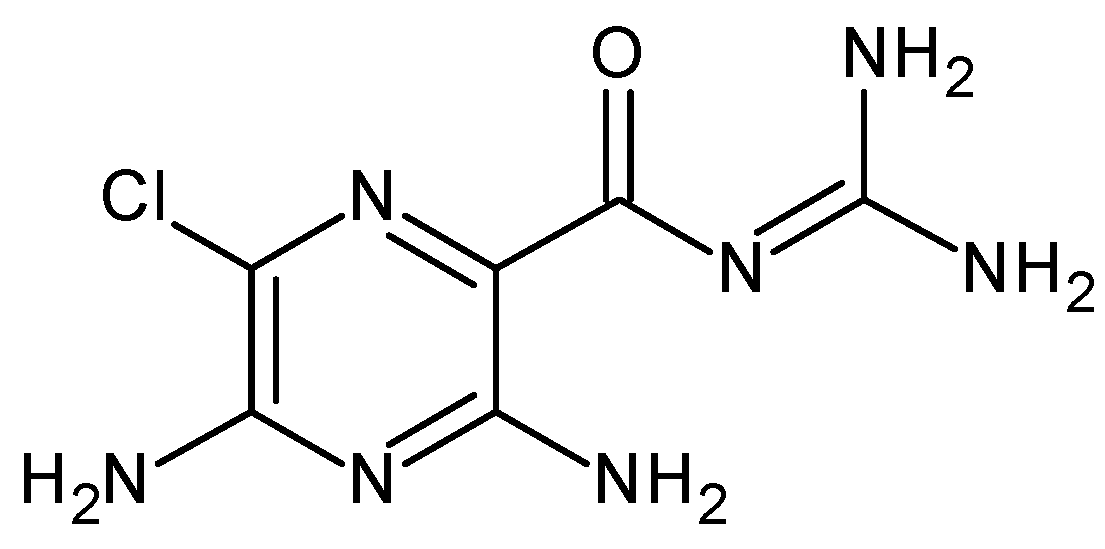
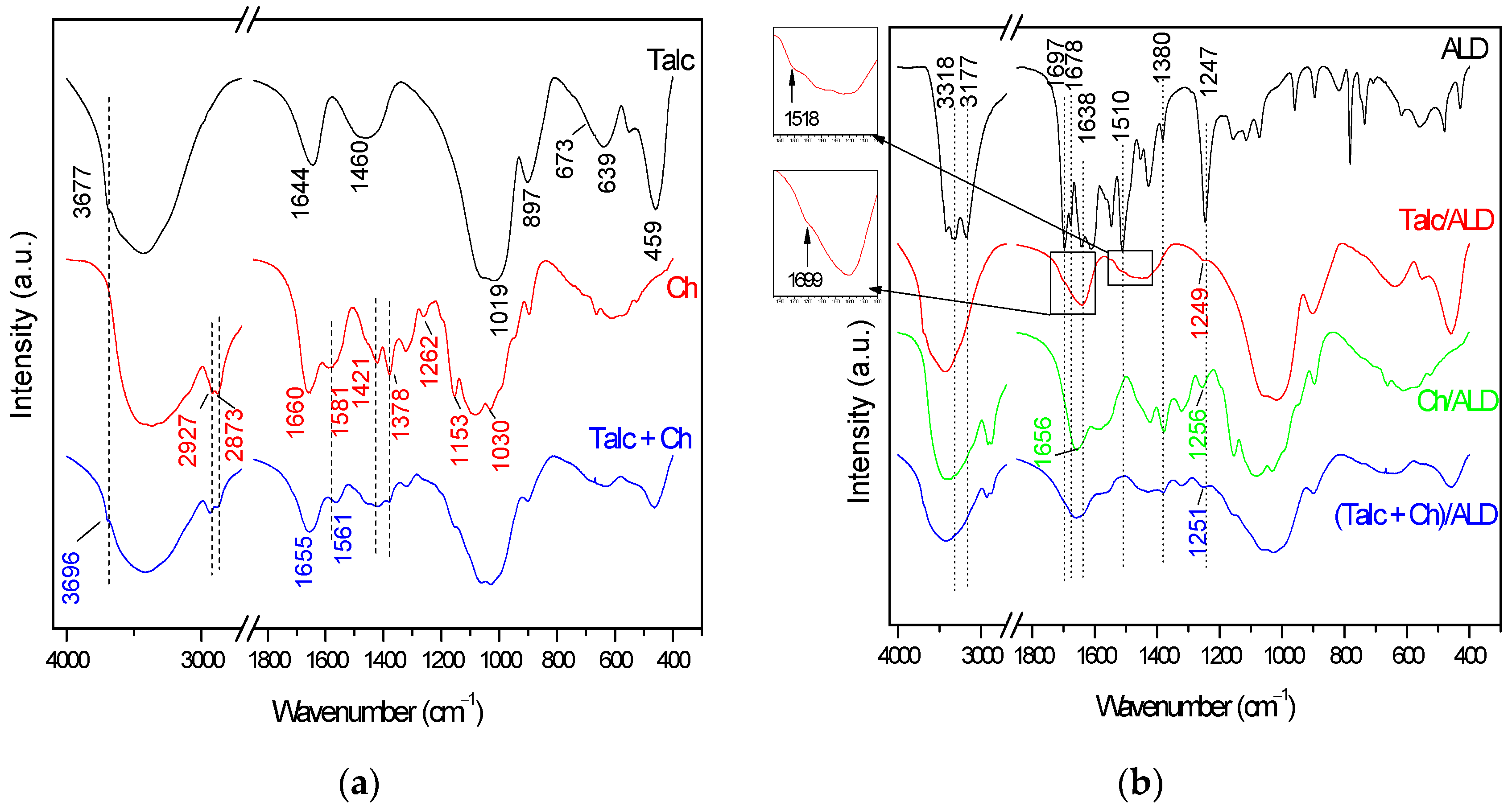

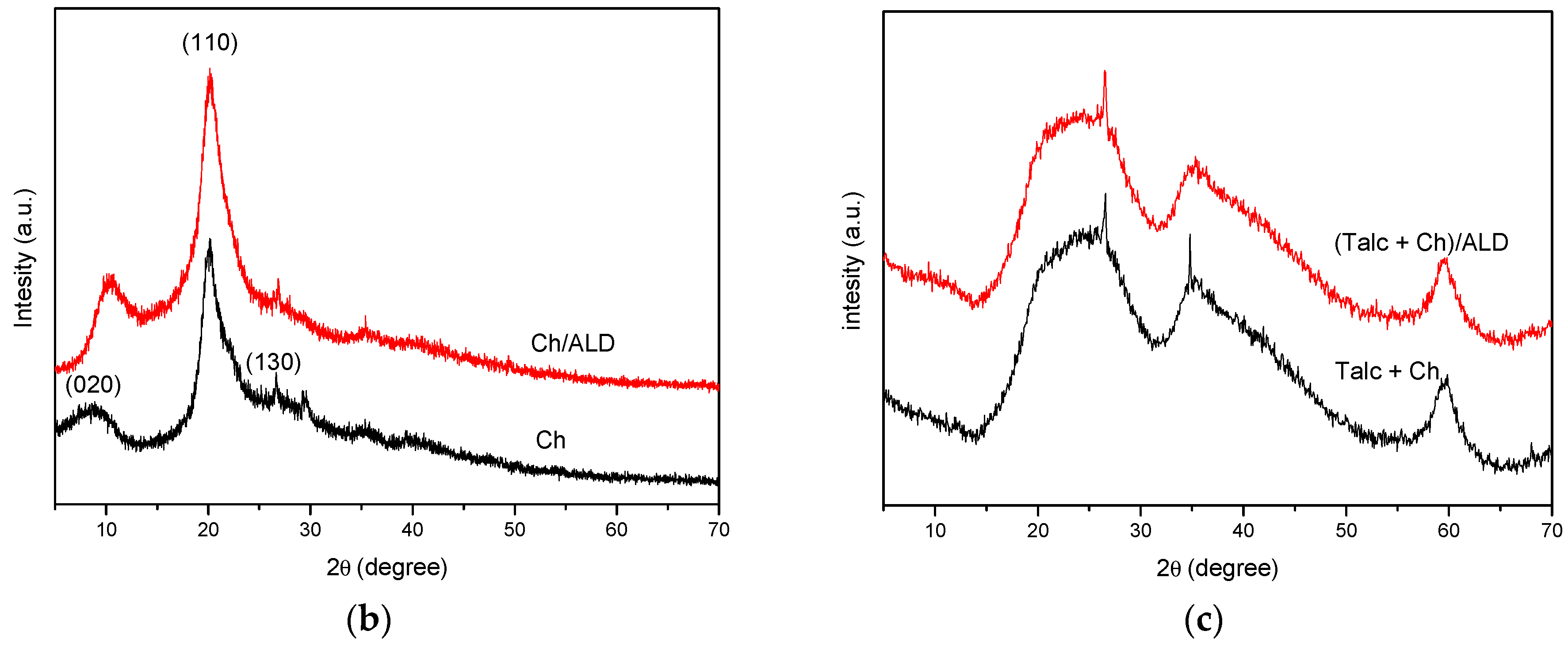

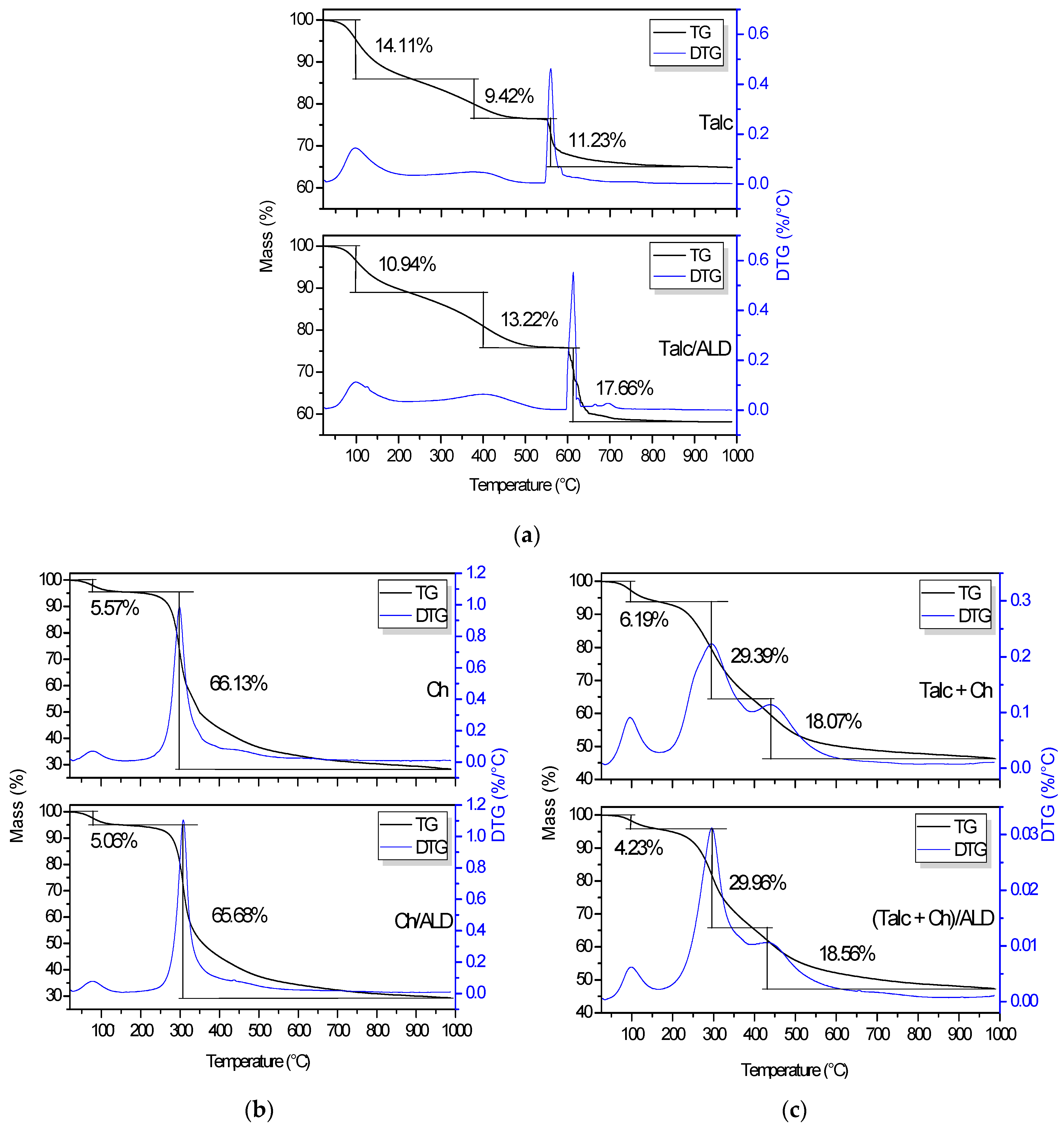
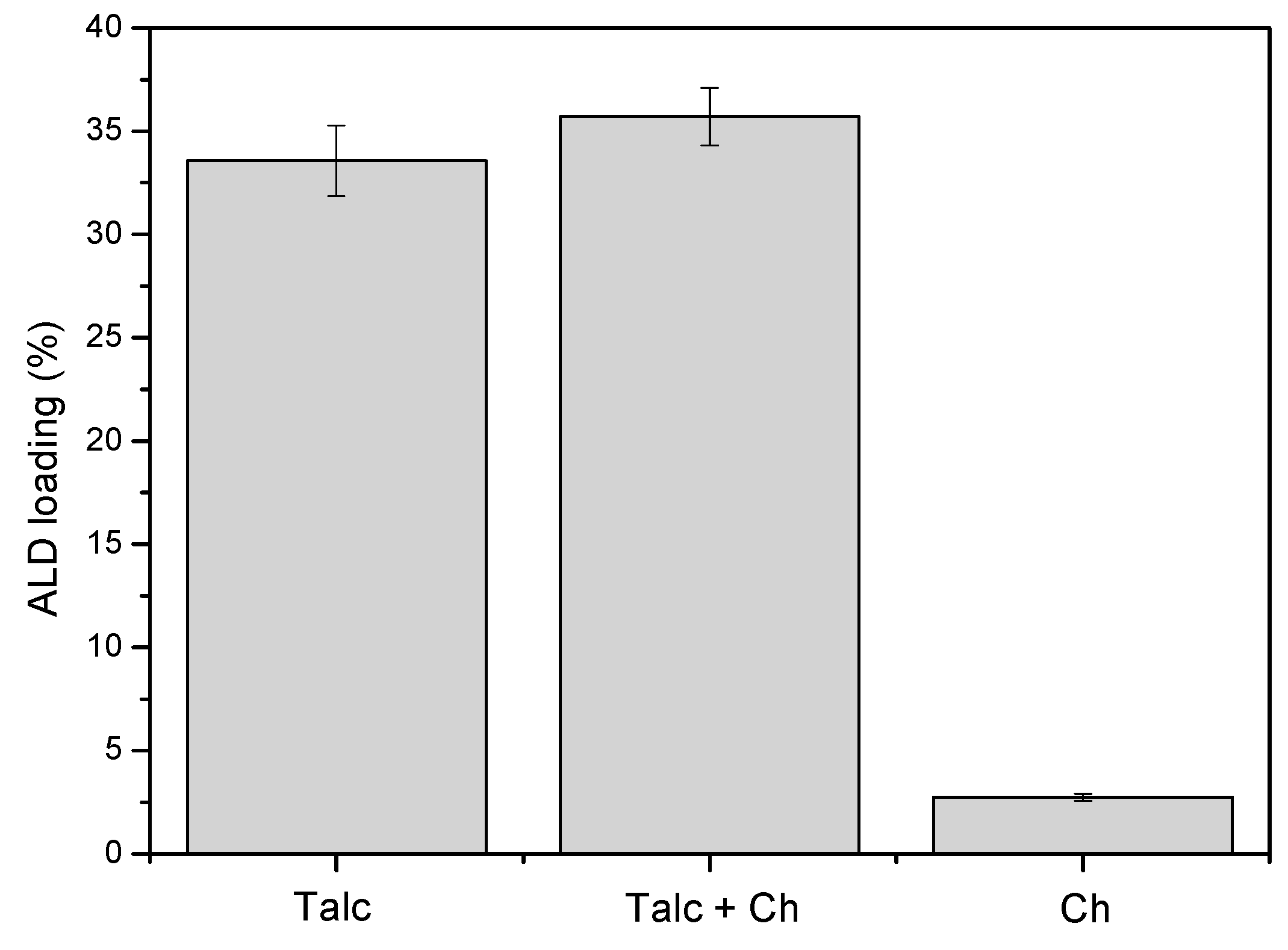

| Material (1 g) | Adsorbed ALD (mg) |
|---|---|
| Talc | 49.53 ± 0.85 |
| Ch | 4.71 ± 0.25 |
| Talc + Ch | 55.74 ± 0.93 |
| Release Models | Samples | |||
|---|---|---|---|---|
| Talc/ALD | (Talc + Ch)/ALD | |||
| Baker–Lonsdale | K | 0.004 | 0.0008 | |
| r2 | 0.8071 | 0.5813 | ||
| Higuchi | K | 4.3281 | 5.4557 | |
| r2 | 0.7084 | 0.3564 | ||
| Korsmeyer–Peppas | K | 15.7826 | 27.9740 | |
| r2 | 0.9821 | 0.9267 | ||
| n | 0.2359 | 0.1656 | ||
| First-Order | K | 0.0054 | - | |
| r2 | 0.2204 | 0.0000 | ||
| Hixson–Crowell | K | 0.0015 | - | |
| r2 | 0.0718 | 0.0000 | ||
| Weibull | K | 60.04 | 85.51 | |
| r2 | 0.9390 | 0.9830 | ||
| b | 0.5818 | 0.1809 | ||
© 2019 by the authors. Licensee MDPI, Basel, Switzerland. This article is an open access article distributed under the terms and conditions of the Creative Commons Attribution (CC BY) license (http://creativecommons.org/licenses/by/4.0/).
Share and Cite
Lima, L.C.B.; Coelho, C.C.; Silva, F.C.; Meneguin, A.B.; Barud, H.S.; Bezerra, R.D.S.; Viseras, C.; Osajima, J.A.; Silva-Filho, E.C. Hybrid Systems Based on Talc and Chitosan for Controlled Drug Release. Materials 2019, 12, 3634. https://doi.org/10.3390/ma12213634
Lima LCB, Coelho CC, Silva FC, Meneguin AB, Barud HS, Bezerra RDS, Viseras C, Osajima JA, Silva-Filho EC. Hybrid Systems Based on Talc and Chitosan for Controlled Drug Release. Materials. 2019; 12(21):3634. https://doi.org/10.3390/ma12213634
Chicago/Turabian StyleLima, Luciano C. B., Caio C. Coelho, Fabrícia C. Silva, Andréia B. Meneguin, Hernane S. Barud, Roosevelt D. S. Bezerra, Cesar Viseras, Josy A. Osajima, and Edson C. Silva-Filho. 2019. "Hybrid Systems Based on Talc and Chitosan for Controlled Drug Release" Materials 12, no. 21: 3634. https://doi.org/10.3390/ma12213634
APA StyleLima, L. C. B., Coelho, C. C., Silva, F. C., Meneguin, A. B., Barud, H. S., Bezerra, R. D. S., Viseras, C., Osajima, J. A., & Silva-Filho, E. C. (2019). Hybrid Systems Based on Talc and Chitosan for Controlled Drug Release. Materials, 12(21), 3634. https://doi.org/10.3390/ma12213634









